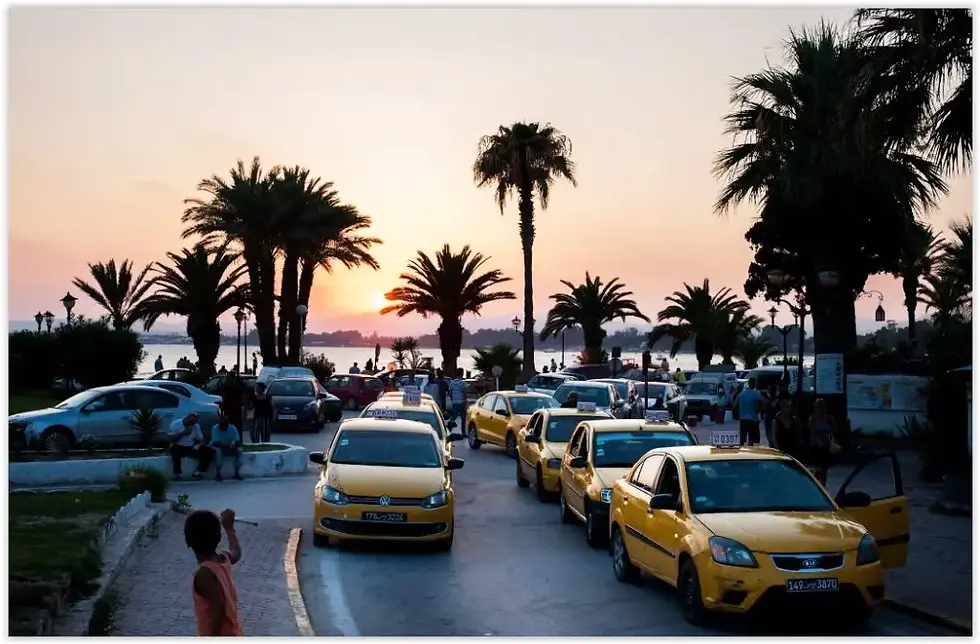Taxi in Tunisia: types, prices and practical tips to avoid getting ripped off!
- Damian Brzeski

- Sep 6
- 10 min read
Did you know that in Tunisia, a red light on the roof of a taxi means it's… free? The country's transportation system can surprise many tourists, and ignorance often leads to overpaying for fares.
How to recognize a genuine yellow taxi, when to choose a louage over a taxi, and how much a ride from the airport to your hotel really costs? This guide will show you how to navigate Tunisian roads without stress or scams.

What taxis look like in Tunisia and their little secret
Fortunately, recognizing an official taxi in Tunisia is incredibly easy. The vast majority of them are distinctive, bright yellow , making them unmistakable.
Every licensed Tunisian taxi must have a sign on the roof with its license number. If it's missing, the driver is likely off duty.
And now a little riddle that can confuse many a tourist. The traffic light system that announces taxi availability works... the exact opposite way here than in Poland! Remember this carefully:
🔴 Red light: The taxi is FREE and will gladly take you.
🟢 Green light: Taxi is BUSY .
Have you ever seen an empty taxi with a green light? It's not a mistake. The driver is likely on their way to pick up a customer who booked a ride through an app, such as a pre-booked economy taxi .
Types of taxis and means of transport – what to choose?
In Tunisia, you have several options for road transportation. The best one for you depends on your travel goals – whether you're planning a quick trip across town or a longer trek into the country.
Yellow Taxi – Your Urban Workhorse
Yellow taxis , affectionately called "petit taxi" (little taxi), are your basic and very convenient means of transportation within city limits and their immediate suburbs.
Most importantly, drivers are legally required to use a taximeter, making it a fair and transparent option for short journeys. A maximum of four people can be accommodated.
Louage – public transport between cities
And now it's time for the true star of Tunisian transport – the Louage (pronounced "luage"), or rather the famous "louage" taxi . It's the absolute backbone of intercity transport .
These are white minibuses or station wagons that serve as shared long-distance taxis. Their routes are easily identified by the colored stripes on their bodywork:
Red Lane: Long-distance routes that connect you to major cities across the country.
Blue Belt: Regional routes, ideal for trips to nearby towns.
Louages depart from special stations ( station de louage ), and the journey begins as soon as a full complement of passengers (usually eight). Prices are fixed and very low, which is why it's the most popular mode of transportation chosen by Tunisians themselves.
Taxi jem3a – a local curiosity in Tunis
If you're in the capital, you might encounter a phenomenon called "taxi jem3a" or "taxi collectif." These are informal shared taxis that operate on fixed routes.
They operate a bit like buses—picking up and dropping off passengers along the way. This is a cheaper option than a traditional taxi , but requires some knowledge of the city's topography.
Taxis in resorts and inland – be careful here!
In popular tourist destinations like Sousse, Hammamet and Djerba, beware of white tourist taxis .
They're usually much more expensive, and their drivers magically forget about the existence of taxi meters, offering predetermined, highly inflated rates. Always try to find a standard, yellow taxi to avoid overpaying.
Price list and tariffs, or how much does it all cost?
Let's talk about money. Understanding taxi prices in Tunisia will help you manage your vacation budget effectively. Generally, taxis are very affordable here, as long as you stick to the rules.
Day and night tariff – how the meter works
Official yellow taxis in Tunisia must use a meter ( compteur in French). Before you drive off, make sure the driver has turned it on. Key fare information:
Entry fee (so-called door slam): This is approximately 0.90 dinars (TND).
Day Rate: Usually valid between 05:00 and 21:00.
Night fare: This is 50% more expensive than the day fare . The good news is that the taximeter switches to it automatically – the driver doesn't have to do it manually.
Prices for travel between cities
Standard yellow taxis won't take you to another city. For that, you'll need the aforementioned Louage (a budget option) or a private car rental (a much more expensive option).
If you decide on the latter, remember that you need to negotiate prices for journeys between cities before getting on the vehicle.
How much does it cost to get from the airport to the hotel?
The ride from the airport to your hotel is the first time you might overpay. Below are approximate taxi fares and a price range you should consider:
Tunis-Carthage Airport (TUN) – Tunis city center: 20-30 TND during the day ( day fare ), up to 45 TND at night. An additional fee for luggage may apply (5-10 TND).
Monastir Airport (MIR) – Sousse city centre: The cost of the ride is approximately 35 TND (approx. 11 EUR).
Djerba Airport (DJE) – Tourist Zone / Houmt Souk: Here you will pay 10-15 TND.
Prices for online and individual transfers
Companies like Welcome Pickups and Kiwitaxi offer online booking. This allows you to arrange a personalized transfer .
The transfer price will be higher, but you will have a guaranteed fixed rate, card payment, and a driver with a nameplate.
Mobile apps (Bolt, Yassir) also provide a price upfront, but it may be higher than the metered rate, especially during peak hours.
You can choose from a variety of economy class vehicles or even order a more luxurious Tunisia sedan transfer .

Airport and city transfers in practice
Airport taxi drivers are just waiting for tired tourists who will take the "first" taxi and pay several times more than necessary.
However, just go a little further or book your transfer online in advance to save yourself stress and money.
And if you are planning a trip between cities, the choice is simple: a louage for those who are budget-conscious and crave local experiences, or a private taxi for those who value comfort and travel without compromise.
Airport transfer – how to organize it wisely
A simple rule: never take the first taxi you see! To avoid stress and scammers, walk a few dozen meters away from the main terminal exit, where the most expensive drivers prey.
Find an official yellow taxi and firmly but politely ask for the meter to be turned on. A locally arranged airport transfer will be the cheapest.
An alternative is of course to book online in advance, e.g. if you are interested in a specific Tunisian transfer .
Intercity transfers – taxi vs louage
The choice is simple and depends on your wallet and traveling style:
Louage: This is an ideal option if you're traveling on a budget and want to experience a true local experience. It's cheap, relatively fast, and safe.
Private taxi: Offers the comfort of door-to-door travel. However, it costs several times more, and you must agree on the price before departure.
Advance booking and card payment
Remember, cash is king! Both standard taxis and Louage accept cash only. Only international platforms and mobile apps offer card bookings and payments. If you're dreaming of a VIP transfer to Tunisia , for example, you can only do so online.
Rules for using taxis - your essentials
Want to avoid stress and unnecessary scuffles with the driver? Just know a few simple rules: always make sure the odometer is working, provide landmarks instead of exact addresses, and if necessary, use apps like Bolt, Yassir, or inDrive.
This will make your travels around Tunisia comfortable, transparent and free from unpleasant surprises.
Counter – Your best friend
In yellow city taxis, using the meter is mandatory. Always make sure the meter is working before getting in or immediately after taking off . The easiest way is to ask with a smile, "Compteur, s'il vous plaît?" ( Meter , please?).
If the driver refuses or turns up his nose, politely thank him, get out and find another, honest driver.
Trouble with street names? Go for landmarks.
The address system in Tunisia can be... conventional. Instead of stressing out about giving an exact address that the driver might not know anyway, choose a well-known hotel, restaurant, monument , or other landmark as your destination. Showing your destination on a map on your phone also works wonders!
Online booking – when is it worth it and how does it work?
Apps such as Bolt , Yassir and inDrive operate in Tunisia.
Bolt and Yassir work similarly to Uber – you see the price of the ride upfront.
inDrive is an interesting option in which you propose the price for the ride, and drivers can accept or reject it.
Using an app is convenient, but not always cheaper. Always compare the price in the app with the estimated fare on the meter.
Safety and potential threats
In Tunisia, taxi drivers have their tricks, and an unaware tourist can be an easy target.
From a trip meter that hasn't been turned on, to "magical" scenic routes, to airport collusion, there are plenty of pitfalls, but each one can be avoided if you know what to expect.
In this section, you will learn about the most common scams, what to watch out for when transporting children or special luggage, and how to cleverly solve the issue of additional stops.
How to avoid getting ripped off? The most common taxi scams.
Meter Not Turning On: A classic of the genre. Always insist on the meter or just get out.
Overpriced "contract" price: The driver offers a fixed price that is two or three times higher than the odometer reading.
Scenic, longer route: This happens especially on airport departures. It's worth keeping the map on your phone open and checking the route.
The problem with getting change: Always carry small change. This will help avoid situations where the driver claims they can't get a larger bill.
Airport Collusion: Especially at Tunis Airport, drivers can be organized, collectively refusing to turn on the meter and charging tourists exorbitant prices. Be assertive or move further away from the terminal.
Transport of children, animals and special equipment
Tunisian taxis rarely have child seats . If you're traveling with a toddler or have unusual luggage (e.g., kitesurfing gear), it's safest to book a private group transfer and let the company know your needs.
You can then choose a vehicle tailored to your requirements, e.g. Minibus 7PAX or even Minibus 16PAX .
Additional stops and waiting times
Want a driver to take you shopping and wait outside? It's best to negotiate such non-standard services in advance, agreeing on an hourly rate or a rate for the entire trip. Trying to implement such a plan while the meter is running can lead to misunderstandings.

Practical Takeaway Tips
Feeling like there's a lot of information out there? No problem! Below, you'll find all the information in a nutshell – your personal cheat sheet and quick FAQ that will prepare you for every encounter with a Tunisian taxi.
Take a screenshot or just take a quick look before you leave the hotel – it's the essence that will save you time, nerves and money.
How to choose the right means of transport – a cheat sheet
Around town: Only a yellow taxi with the meter on!
Between cities (budget): Definitely Louage .
From/to the airport (convenient): Transfer booked online or via app.
To/from the airport (economical): Yellow taxi from a short distance from the main entrance.
When is online transfer profitable?
Booking online is a great choice when you're traveling at night, in a large group, with a lot of luggage, or simply want peace of mind and a predictable fare right after landing.
What you need to know before your first taxi ride in Tunisia
Cash, cash, cash! Always carry spare Tunisian dinars.
Red means slow: Get the inverted roof light system into your head.
Fasten your seat belt: In Tunisia, front-seat passengers are required to wear their seat belts. Interestingly, any fines are paid by you, not the driver!
Think in terms of landmarks: It will make your life and communication with every driver easier.
Be firm, but with a smile: Communicate your expectations clearly, especially regarding the meter. Basic French phrases ( bonjour, merci, s'il vous plaît ) can work wonders and open many hearts.
Tunisian Taxi: Quick FAQ
Before the trip
What color are official taxis? Yellow. These are the so-called "petit taxis" for city driving.
How can you tell if a taxi is free? It has a red light on its roof. Red = free, green = occupied.
Do I need cash? Yes, absolutely. Taxis don't accept cards. Carry some change in dinars (TND).
Do the drivers speak English? Very rarely. It's much easier to communicate in French.
What taxi apps work in Tunisia? Mainly Bolt, Yassir, and inDrive.
Is the app always cheaper? Not always. It's worth comparing the price in the app with the estimated fare on the odometer.
How do I enter my destination if I don't know the address? Use the name of a well-known hotel, restaurant, or landmark, or show the destination on a map on my phone.
During the trip
Does the driver have to turn on the taximeter (meter)? In yellow taxis in the city – yes, it's their responsibility.
What should you do if the driver refuses to turn on the meter? Politely thank them, get out, and find another one. This is the most common fraud attempt.
Do I have to wear a seatbelt? Yes, it's mandatory in the front seat. The fine for not wearing a seatbelt is paid by the passenger, not the driver.
How many passengers can ride in a taxi? Maximum four.
Can I eat or drink in a taxi? It's generally frowned upon. It's best to avoid it.
Can I ask for the air conditioning to be turned on? Yes, you can ask ("clim, s'il vous plaît?"), but not all taxis have it or use it.
Payments and prices
What is the entry fee? Approximately 0.90 dinars.
Is there a night rate? Yes, it's usually valid from 9:00 PM to 5:00 AM and is 50% more expensive.
Is there an extra charge for luggage? Sometimes yes, especially on airport transfers. It's usually a few extra dinars.
Is it necessary to tip? It's not mandatory, but it's a nice gesture to round up the bill.
What should you do if the driver says he doesn't have change? That's why it's always a good idea to have spare change. It's a common excuse for getting a bigger tip.
Types of transport
What is a "louage"? It's a white minibus or station wagon, a long-distance shared taxi for traveling between cities.
How does the "louage" work? It has a fixed route and price. It departs from a special station ( station de louage ) when it's full.
What is a "taxi touristique"? Typically a white taxi in resort towns, it's more expensive and often uses a taximeter—it's best to avoid it.
What is a "taxi jem3a"? It's an informal shared taxi service in Tunis, operating on fixed routes like a bus.
Security and airports
Are taxis safe? Yes, transportation is generally safe. However, it's worth taking basic precautions.
How to avoid airport scams? Don't take the first taxi from the rank. Walk a short distance from the main exit and look for a yellow taxi, insisting on the meter.
What should I do if I forget something in a taxi? Unfortunately, the chances of recovering it are slim. Always check your belongings before leaving.
































































Comments